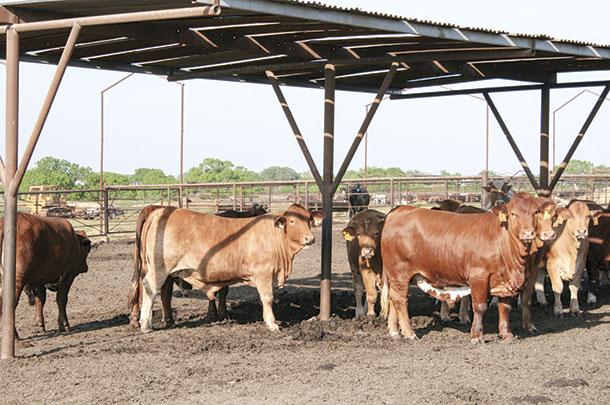Each situation requires some attention to shelter, in extreme temperatures and in other adverse weather conditions.
Recently, a greater emphasis has been placed on providing shade to cattle during hot summer months, especially to those in confinement.
While shade is common in most feedlot situations, it is important for all livestock, regardless of where they are managed, to be provided shade and water on hot, sunny days to mitigate decreases in health and production from heat stress.
Understanding heat stress in cattle
Mammals regulate their internal body temperature as environmental temperatures fluctuate through involuntary means, such as shivering or sweating. These methods for maintaining internal body temperature require increased energy expenditures, and when the external temperature reaches extreme highs or lows, the animal’s system may become overwhelmed.
Cattle are typically able to handle environmental temperatures of up to 85 to 90ºF; however, as temperatures rise above 90ºF, they will exhibit increased panting, sweating and heart rate, and will decrease their feed intake.
Decreased feed intake only exacerbates the problem because an animal requires increased energy to dissipate the heat. Furthermore, cattle will increase their water intake during extreme heat, which may result in an electrolyte imbalance, especially in combination with decreased feed intake.
Taken altogether, these responses to extreme heat can result in heat stress and, subsequently, decreased health and production or, in extreme cases, may result in death.
Some individual animals are more susceptible than others to heat stress, including overweight animals, those that are young or old, animals at peak lactation, or those that are sick or emaciated (because illness is often associated with dehydration and depleted energy levels).
Animals that fall in these categories should be monitored more closely as temperatures surpass 85 to 90ºF. It is also important to consider where animals are managed.
Because trees and other vegetation absorb heat from the sun, cattle grazing on pasture or range are not at as high of risk of heat stress as cattle in drylots. Drylots and bare dirt patches reflect the sun rays from the ground, which increases the “feels-like” temperature in those areas.
Additionally, increased levels of humidity and days where there is little or no wind can intensify heat stress. Finally, if overnight temperatures remain too high, the animals will not have a chance to cool off in between hot days.
Mitigating heat stress
There are several ways in which to manage cattle for heat. The most important strategy to alleviate heat stress is to provide adequate water and feed. Particularly in extreme heat, ensure the distance to water and feed is close enough to avoid unnecessary energy exertion but still at enough of a distance that some cattle in the group are not crowded out.
Additionally, providing a salt and mineral supplement may reduce issues associated with electrolyte imbalance when water consumption increases on hot days. Furthermore, when feeding cattle in the summer heat, provide feed during the cooler parts of the day (morning or evening) to encourage sufficient feed intake.
Finally, providing shade for livestock to get out of the direct sun can decrease their heat load by up to 50 percent and may help maintain feed intake. Cattle with access to shade typically have improved gains over those with access to limited or no shade.
Strategies for providing shade
Providing shade may be very important in some circumstances, such as areas where persistent summer temperatures are consistently above 85 to 90ºF in combination with high humidity and little or no wind, or in drylot settings and areas with little grass. In some cases, shade may be less warranted, such as areas where temperatures rarely rise above 90ºF or for cattle grazing on rangeland where there are trees and other natural options for shade.
Shade considerations
When considering the type of shelter or shade to provide to cattle, evaluate existing options, such as the presence of trees or existing permanent buildings. Next, assess the number of animals that will need to be provided shade and how far and frequently they will be moving.
Some operations rely on just a few pens or pastures year-round, and some may rotate cattle through several pastures so that each pasture is only once per year. Finally, consider the financial costs of installing different types of shelters and the challenges involved with maintenance and cleaning underneath the shelter or shade.
Adult cattle require 20 to 50 square feet of shade per animal with at least 10 to 12 feet of overhead clearance. Developing shade structures for pasture and range cattle may be less practical, but efforts to increase shade availability can improve cattle performance.
Other considerations include distance to water and feed, and to other structures. Ensure proper air circulation by not placing shade structures too close to other structures. Depending on the needs and resources, shelters may be permanent, natural or portable.
Permanent shelters
Permanent shelters include barns, open-sided sheds or pole buildings and may require the greatest cost up-front. However, these types of shelters can typically be multi-purposed for year-round use, in all weather extremes and conditions.

This type of shelter is most useful for operations with confined cattle or those with cattle in a single pasture year-round or several times throughout the year, and especially when weather conditions are dramatically different between those times of year. Permanent shelter structures must be built to tolerate changing weather conditions, including wind speeds, snow load and rainfall typical for the area.
Natural shelters
Natural shade may be in the form of existing or planted trees and brush, or may be other natural barriers like canyons and hills that block afternoon sunlight. Taking advantage of these types of shelters can be beneficial financially and may be better sources of shade and heat dissipation than man-built shelters.
Trees have an even greater cooling effect for livestock than man-built shelters because the leaves absorb heat, especially trees with broad leaves or canopies.
Natural shelters are great for blocking the sun and can also double as shelter for extreme weather and wind conditions year-round. These live shelters (natural or planted) may be most significant for pasture or rangeland cattle, where there are often a large number of animals and the landscape may not be practical for building structures large enough to accommodate their needs.
Portable shelters
Portable shades can be built from a welded pipe frame (or other materials) and covered with shade cloth. This type of shade is often utilized when it needs to move with the livestock to new pens or pastures, or if the shelter is not needed in an area during winter months. These structures can be completely or partially dismantled when not needed or prior to winter.
It is generally recommended that an 80 percent shade cloth be used for these types of portable shades; however, it may be beneficial in some cases to have a full roof (made from sheet metal or something similar). Set up the portable structure for maximum sun blockage (longest side running north to south), especially for the warmest sun in the afternoon.
Portable structures may be built with a skid bottom for easy moving if the frame needs to be moved periodically to different pens or pastures.
If the frame does not need to be moved, permanently securing the legs in the ground while easily being able to remove the roof or cover may be the better option. It is important to ensure the frame can withstand any rubbing or rough-housing the cattle may inflict.
Furthermore, be sensible about the size of a portable shade frame, especially for those that will be moved regularly. Finally, install the roof or cover with a pitch that allows moisture to run off and secure it adequately to avoid excess movement or destruction in extreme wind speeds.
Regardless of the type of shade or shelter provided to cattle, giving them the option to get out of the sun may ultimately improve productivity and maintain good health throughout the hot summer months. In the meantime, we will keep our fingers crossed for a mild, productive summer. ![]()
PHOTO 1: Count the number of animals needing shade and how far and frequently they will move.
PHOTO 2: Permanent shelters can typically be multi-purposed for year-round use, in all weather extremes and conditions. Staff photos.
Melinda Ellison is a range livestock extension specialist with the University of Idaho.
Nancy M. Cummings is with the research, extension and education center, animal and veterinary science department at the University of Idaho.








